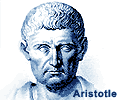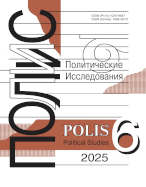Cleavage Theory and Theory of Issue Dimensions:
Cross-Points
DOI: 10.17976/jpps/2019.06.08
Korgunyuk Yu.G. Cleavage Theory and Theory of Issue Dimensions: Cross-Points. – Polis. Political Studies. 2019. No. 6. https://doi.org/10.17976/jpps/2019.06.08
The article analyzes drawbacks of the methodology behind the project “Manifesto”, which make it reveal the structure of party documents over issue dimensions and political cleavages. These drawbacks are: its emphasis on issue salience instead of parties' issue positions; bringing the content of party manifestos under broad categories formulated at the beginning of the project and little adapted to situations in non-Western countries; a somewhat inappropriate technique for factor analysis. An alternative methodology is proposed that shifts the focus to parties' positions on issues which cause the biggest polarization. It also expands the range of studied documents at the expense of interviews and transcripts of debates, limits the study to a single election campaign, and makes adjustments to the procedure of factor analysis. As a result, it allows identification of the structure of issue dimensions, not of manifestos. In order to reveal political cleavages inside these dimensions, starting from so called electoral cleavages is proposed; these are detected by a factor analysis of the vote shares received by parties in different territorial units. Factor loadings of parties in the electoral space are compared through correlation analysis with their factor loadings in the political space; for more accurate results parties' issue positions in separate issue domains are analyzed. The proposed methodology is applied to the analysis of the elections to the Russian State Duma (2016) and German Bundestag (2017). It revealed that the Russian political space is structured by three conflict dimensions: systemic, authoritarian-democratic, and socioeconomic; the German one, however, is structured by only two: systemic (GAL/TAN with dominance of the transnational cleavage) and socioeconomic. With all this, the electoral space of Russia is dominated by the authoritarian-democratic cleavage, whereas the second electoral cleavage has a combined nature (socioeconomic + systemic). In Germany, the first electoral cleavage is systemic while the second one is socioeconomic.
References
Albright J.J. 2010. The Multidimensional Nature of Party Competition. – Party Politics. Vol. 16. No. 6. P. 699-719. https://doi.org/10.1177/1354068809345856
Bornschier S. 2010. Cleavage Politics and the Populist Right: The New Cultural Conflict in Western Europe. Philadelphia: Temple University Press. 345 p. https://doi.org/10.1017/s1537592711001836
Budge I. 1987. The internal analysis of election programmes. – Ideology, Strategy and Party Change: Spatial Analyses of Post-War Election Programmes in 19 Democracies, Budge I., Robertson D., Hearl D. (eds.). Cambridge, Cambridge University Press. P. 15-38.
Budge I., Homola J. 2012. How Far Have European Political Parties Followed the Americans to the Right in the Later Post-War Period? – Cambio. Rivista sulle Trasformazioni Sociali. No. 2 (4). P. 71-86. https://doi.org/10.1017/cbo9780511558771.003
Butler D., Stokes D.E. 1971. Political Change in Britain. New York: St. Martin’s Press. 516 p.
Coman E. 2017. Dimensions of political conflict in West and East: An application of vote scaling to 22 European parliaments. – Party Politics. Vol. 23. No. 3. P. 248-261. https://doi.org/10.1177/1354068815593454
Franklin M. 1992. The decline of cleavage politics. – Electoral change: Responses to evolving social and attitudinal structures in Western countries. Franklin M., Mackie T., Valen H. (eds.). Cambridge, UK: Cambridge University Press. P. 381-402. https://doi.org/10.2307/2132377
Ginsberg B. 1976. Elections and Public Policy. – American Political Science Review. Vol. 70, N. 1. P. 41-49.
Häusermann S., Kriesi H. 2015. What do voters want? Dimensions and configurations in individual-level preferences and party choice. – The Politics of Advanced Capitalism. Cambridge: Cambridge University Press. P. 202-230. https://doi.org/10.1017/cbo9781316163245.009
Hooghe L., Marks G., Wilson C.J. 2002. Does left/right structure party positions on European integration? – Comparative Political Studies. Vol. 35. No. 8. P. 965-989. https://doi.org/10.1177/001041402236310
Hooghe L., Marks G. 2018. Cleavage theory meets Europe’s crises: Lipset, Rokkan, and the transnational cleavage. – Journal of European Public Policy. Vol. 25, № 1. P. 109-135. https://doi.org/10.1080/135 01763.2017.1310279
Huber J., Inglehart R. 1995. Expert interpretations of party space and party locations in 42 societies. – Party Politics. Vol 1. No.1 P. 73-111. https://doi.org/10.1177/1354068895001001004
Inglehart R. 1990. Cultural shift in advanced industrial society. Princeton, NJ: Princeton University Press. 484 p.
Irvine W.P. 1987. Canada 1945-1980: party platforms and campaign strategies. – Ideology, Strategy and Party Change: Spatial Analyses of Post-War Election Programmes in 19 Democracies, Budge I., Robertson D., Hearl D. (eds.). Cambridge, Cambridge University Press. P. 73-94. https://doi.org/10.1017/cbo9780511558771.005
Kriesi H., Grande E., Lachat R., Dolezal M., Bornschier S., Frey T. 2006. Globalization and the Transformation of the National Political Space: Six European Countries Compared. – European Journal of Political Research. Vol. 45. No. 6. P. 921-956. https://doi.org/10.1111/j.1475-6765.2006.00644.x
Kriesi H. et al. 2012. Political Conflict in Western Europe. Cambridge: Cambridge University Press. 349 p.
Lachat R. 2018. Which Way from Left to Right? On the Relation Between Voters’ Issue Preferences and Left–Right Orientation in West European Democracies. – International Political Science Review. Vol. 39. No. 4. P. 419-435. https://doi.org/10.1177/0192512117692644
Lijphart A. 2012. Patterns of democracy. Government Forms and Performance in Thirty-Six Countries. New Haven & London, Yale University Press. XX, 348 p. https://doi.org/10.1007/978-3-531-90400-9_64
Lipset S.-M., Rokkan S. 1967. Cleavage Structures, Party Systems, and Voter Alignments: an Introduction. – Party Systems and Voter Alignments: Cross-National Perspective, Lipset S.-M., Rokkan S. (eds.). New York, Free Press. P. 1-61. https://doi.org/10.1007/978-3-531-90400-9_68
Marcinkiewicz K. 2018. The Economy or an Urban–Rural Divide? Explaining Spatial Patterns of Voting Behaviour in Poland. – East European Politics and Societies and Cultures. Vol. 32. No. 4. P. 693-719. https://doi.org/10.1177/0888325417739955
Matiuta C. 2018. Political cleavages in post-communist Europe. Romania as a case study. – Yearbook of the Institute of East-Central Europe. Vol. 16. No. 3. P. 147-164.
Namenwirth J.Z., Lasswell H. 1970. The Changing Language of American Values: A Computer Study of Selected Party Platforms. Beverly Hills: Sage. 68 p.
New politics in Western Europe: The rise and success of Green Parties and alternative lists. 1989. Ed. by F. Müller-Rommel. Boulder, CO: Westview. https://doi.org/10.4324/9780429044298
Nagel J. 2006. Occam no, Archimedes yes. – Democratic Politics and Party Competition. Essays in honour of Ian Budge, Bara J., Weale A. (eds.). London and New York, Routledge. P. 143-158.
Robertson D. 1976. A Theory of Party Competition. London & New York: Wile. 210 p.
Rovny J., Polk J. 2019. New wine in old bottles: Explaining the dimensional structure of European party systems. – Party Politics. Vol. 25. No. 1. P. 12-24. https://doi.org/10.1177/1354068817752518
Rovny J., Whitefield S. 2019. Issue dimensionality and party competition in turbulent times. – Party Politics. Vol. 25. No. 1. P. 4-11. https://doi.org/10.1177/1354068818816970
Schneider W. 1974. Issues, Voting, and Cleavages. A Methodology and Some Tests. – American Behavioral Scientist. Vol. 18 No. 1. P. 111-146. https://doi.org/10.1177/000276427401800106
Stanley B. 2019. A New Populist Divide? Correspondences of Supply and Demand in the 2015 Polish Parliamentary Elections. – East European Politics and Societies and Cultures. Vol. 33. No. 1. P. 17-43. https://doi.org/10.1177/0888325418783056
Stoll H. 2004. Social Cleavages, Political Institutions and Party Systems: Putting Preferences Back into the Fundamental Equation of Politics. A Dissertation Submitted to the Department of Political Science and the Committee on Graduate Studies in Partial Fulfilment of the Requirements for the Degree of Doctor of Philosophy. Santa Barbara: University of California. URL: http://www.polsci.ucsb.edu/faculty/hstoll/research/thesis.pdf (accessed 27.04.2019).
Teney C., Lacewell O.P., de Wilde P. 2014. Winners and losers of globalization in Europe: attitudes and ideologies. – European Political Science Review. Vol. 6. No. 4. P. 575-595. https://doi.org/10.1017/s1755773913000246
Torcal M., Mainwaring S. 2002. The Political Recrafting of Social Bases of Party Competition: Chile, 1973-95. – British Journal of Political Science. Vol. 33. No. 1. P. 55-84. https://doi.org/10.1017/s0007123403000036
Warwick P.V. 2002. Toward a common dimensionality in West European policy space. – Party Politics. Vol. 8. No. 1. P. 101-122. https://doi.org/10.1177/1354068802008001005
Whitefield S., Rohrschneider R. 2019. Embedding integration: How European integration splits mainstream parties. – Party Politics. Vol. 25. No. 1. P. 25-35. https://doi.org/10.1177/1354068818816976
Korgunyuk Yu.G. 2017. Election by proportional system as a mass opinion poll. – Political Science (RU). No. 1. P. 90-119. (In Russ.)
Korgunyuk Yu. 2019. New Instruments for Measuring Electoral Cleavages: from macro- to micro-level. – Electoral Politics. No. 1. (In Russ.) URL: http://electoralpolitics.org/en/articles/novye-instrumenty-izmereniia-elektoralnykh-razmezhevanii-ot-makro-k-mikrourovniu (accessed 08.07.2019).
See also:
Korgunyuk Yu.G.,
The 2012-2014 Party Reform and the Structure of the Electoral Divides in Russia’s Regions. – Polis. Political Studies. 2015. No4
Kudryashova I.V., Kozintsev A.S.,
Revisiting cleavage structures: Islamic parties and nation-state formation in the Arab world. – Polis. Political Studies. 2023. No3
Suvakovic U.,
Political parties as traditional mechanisms of representation in modern societies. – Polis. Political Studies. 2010. No2
Semenenko I.S., Lapkin V.V., Pantin V.I.,
Social Cleavages and Political Divides in a Theoretical Perspective: Criteria for Assessment and Classification. – Polis. Political Studies. 2021. No5
Gelman V.Ya.,
Political Parties in Russia: from Competition – to Hierarchy. – Polis. Political Studies. 2008. No5




.jpg)






 print
print
.jpg)
.jpg)